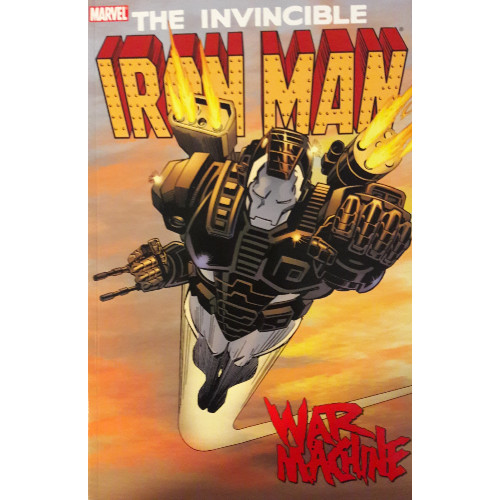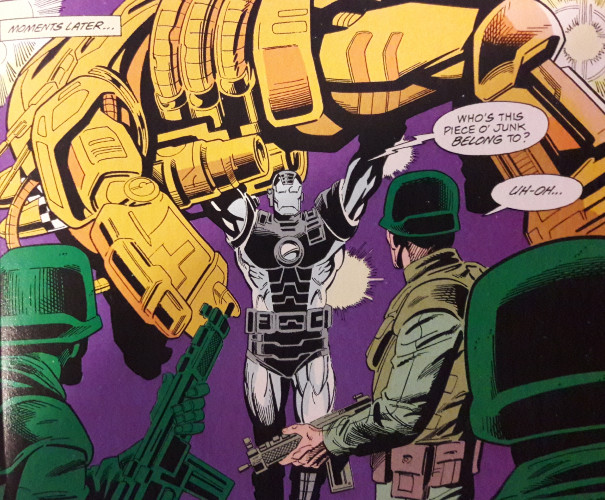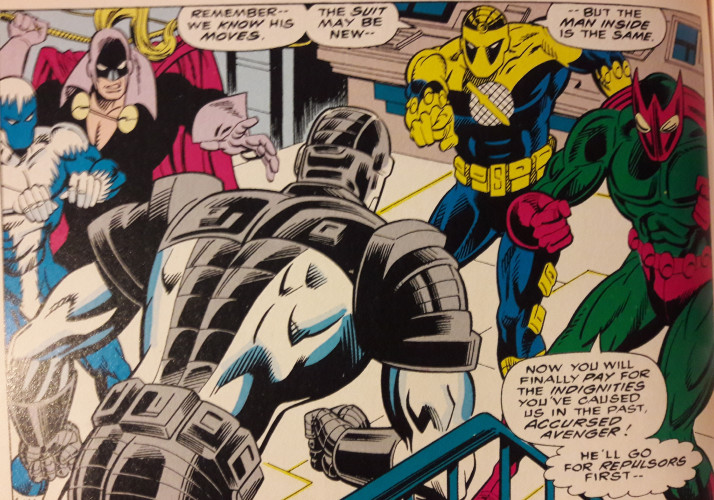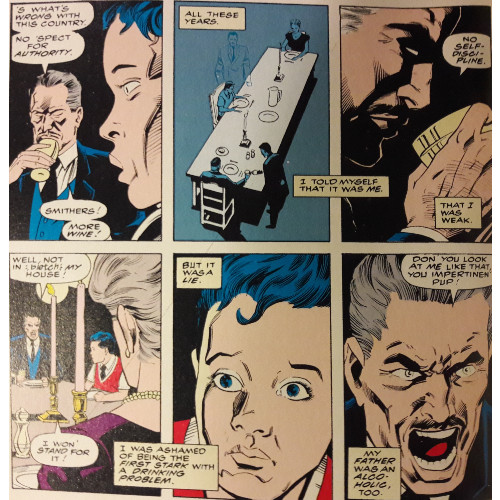(Strand)om Stories: Iron Man: War Machine Review
Even though it fumbles an engaging twist, this slim volume provides a character-driven arc for James "Rhodey" Rhodes, letting him become his own hero
—by Nathan on April 22, 2023—

Having (relatively) recently devoted a post to a series of 1991 Spidey annuals about a narrative featuring both Iron Man and Black Panther, I thought it prudent to follow up with a few posts detailing recent Black Panther/Iron Man stories I perused. The Panther narrative took place in the early 2000s, but this particular Iron Man tale was published the year after the “Vibranium Vendetta” team-up. Cool as it would be for there to exist some kind of narrative connection, I cannot make that claim.
What we have here is a slim volume, collecting a handful of sequential issues from the main Iron Man series, and it holds a surprising place in my memory. My dad often associates Chicago Bears games to important dates–“Oh, yeah, that’s the same day the Bears lost to the Green Bay Packers in 20XX!” he’ll say, tethering the game to someone’s birthday or a trip or a social event. I tend to do the same with comics. Thanksgiving always reminds me of the first time I read The Long Halloween; I associate Walt Simonon’s Mighty Thor run with a trip to Florida where I read a portion of his work; I read the first several issues of Spidey’s “Brand New Day” arc on a plane from London to Chicago.
A vague memory exists with this War Machine volume–I recall picking the volume up from the library…and I remember being confused. Back in my earlier days of reading comics, I didn’t understand as much Marvel lore and couldn’t piece narratives or histories together easily. I had little to no clue why, all of a sudden, Tony Stark wasn’t Iron Man.
James “Rhodey” Rhodes had stepped up to bat. He donned the Iron Man armor…but instead of simply using his boss’ famed moniker, as he had in the past, Rhodey decided to become his own man, sans-iron.
Thus was born…the War Machine.
Iron Man: War Machine
Writer: Len Kaminski
Pencilers: Kevin Hopgood, Barry Kitson, and Tom Morgan
Inkers: Andrew Pepoy, Bob Wiacek, Mike DeCarlo, Chris Ivy, Brad Vancata, and Steve Mitchell
Colorists: Mike Rockwitz and Ariane Lenshoek
Letterers: Michael Heisler, Chris Eliopolous, and John Costanza
Issues Collected: Iron Man #280-291
Volume Publication Date: May 2008
Issue Publication Dates: May 1992-April 1993

This isn’t James Rhodes first “Rhodey-o.”
As referenced above, Tony Stark’s best friend had, periodically, donned the Iron Man armor in times of need. He wore it during the first Secret Wars, during David Michelinie's “Armor Wars” story arc, and during a science convention where he and Spider-Man teamed up to fight Blacklash.
At least, those are the stories I own where Rhodey temporarily became a man of iron.

Here, Rhodey becomes his own hero. I was somewhat surprised to learn this was the first time the War Machine armor came into play. I had assumed, with the character having been around for a few decades by this point, Rhodey became War Machine prior to the 90s. But no. This is his first outing as a non-Iron Man iron man.
The setup: Tony Stark, infected by a techno-organic parasite, is dying. He’s a futurist without a future. This isn’t some villain he can punch in the face, a conspiracy he can unravel, or a bottle he can throw away. This is a disease, like a cancer, eating him from the inside out. And as part of his Last Will and Testament, he bequeaths not only his company, Stark Enterprisies, into Rhodey’s capable hands but his position as company bodyguard/corporate mascot/superhero/West Coast Avenger.

Writer Len Kaminski plays well with Rhodey’s complicated emotions and reactions to this loaded burden, especially when it appears Stark has succumbed to his illness. I am not aware how often Rhodey was allowed to be his own man in the Iron Man mythos, rather than playing second fiddle to Stark. In the few comics I own, he plays an important role but is always saddled in the best friend/partner position. He’s the pilot, the guy who has Stark’s back. Kaminski genuinely allows Rhodey some decent characterization as he steps into two roles–as War Machine and head of Stark Enterprises as Stark’s condition worsens.
Kaminski nicely captures the mixed stressed and determined emotions Rhodey juggles. One the one iron-gloved hand, Rhodey makes some important decisions quickly, taking charge and deciding the company’s immediate future. On the other, he’s weighed down mentally by inheriting the company, which comes as a shock, as well as his War Machine duties. A brief fracas with the West Coast Avengers (who definitely know Tony Stark’s no longer wearing the armor) and a personal tragedy rock his confidence, balanced out by a couple heroic stints against vengeful enemies. Rhodey inherits not only the armor and the company but the duties, responsibilities, and enemies which come with both suits. This is his "baptism of iron," coming into a legacy constructed by another man yet keeping his own identity.

In the background, Kaminski weaves Stark’s fate as the illness grows worse–an engaging backup strip, included in issue #288 and illustrated by Barry Kitson, plus some scattered pages in other issues, revisit the futurist’s past. Fortunately, Kaminski steers clear of reiterating Stark’s famed origin for a more human lens, peering into his family life and how his father’s influence affected the man Stark became. I don’t know if or how other writers seeded Howard Stark’s parenting into prior tales, but Kaminski points out a casual alcoholism, which the son may have inherited from the father, and a desire to escape the confines which Howard placed his son in. Stark, here, is given an opportunity to reshape himself, again, away from both his father’s influence and a body ravaged by disease.
Stark survives his illness. No spoiler there. The Iron Avenger graces comics pages to this day. But I find myself flipping between two perspectives: Kaminski’s early admission to audiences that Stark is alive and well and the hypothetical possibility of keeping Stark’s survival in the dark for longer. Rhodey is left oblivious. He, and the world, believe industrialist Tony Stark dead. Rhodey gives an impassioned eulogy, dumps Stark’s ashes (or, well, somebody’s ashes? egh) off the roof of Stark Enterprises. We see Rhodey’s struggles and grief and know they’re predicated on a lie. We understand Stark’s intentions, but I wonder, for the reader in 1992, would keeping Stark’s survival under wraps have been effective? Bigger spoiler, but Rhodey discovers his friend’s duplicity and acts accordingly. He’s angry, feels cheated and thrust into a position under false pretenses. I wonder if Kaminski’s decision to let audiences into the fold undercuts Rhodey’s emotional struggles. Even for the modern reader aware of Stark’s survival prior to ever picking up this volume, following Rhodey’s perspective, genuinely believing his best friend is gone forever, adds an emotional tether to War Machine that our inside information damages.

But the good far outweighs the poor here. As noted, Kaminski effectively gives us a chrome-covered champion to root for, even if his intentions are based on a best friend’s lie. James Rhodes becomes his own man, even as Tony Stark is forced to face his own mortality and wonder who he should be moving forward. Fans of either character are encouraged to pick this volume up. There’s no shortage of action–if Iron Man fighting technologically advanced ninjas isn’t your style, maybe you’ll appreciate a raid on Justin Hammer’s houseboat hideout, a skirmish between the West Coast Avengers and “usual suspect” Iron Man villains Beetle, Spymaster, Blizzard, and Blacklash, or War Machine single-handedly defeating a vengeful Living Laser. Though I do wish Kaminski had toyed with the “mystery” of Stark’s survival, moot an idea that seems three decades later, I appreciate most of what he creates here. We get a look at a man who isn’t made of iron, a different face within the mythos given the chance to step out of his brother’s shadow.